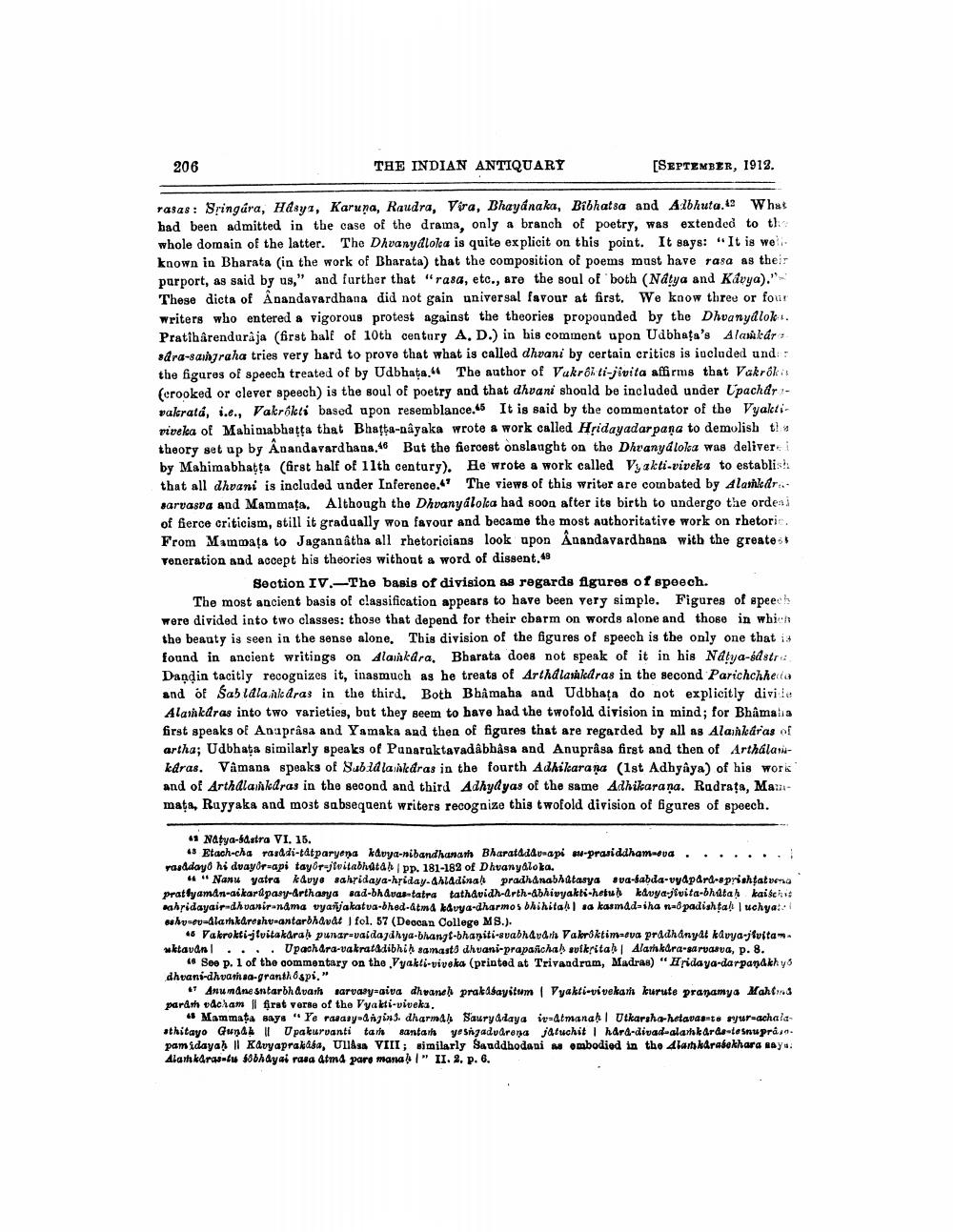________________
206
THE INDIAN ANTIQUARY
(SEPTEMBER, 1912.
rasas: Sringára, Hasyi, Karuna, Raudra, Vira, Bhayánaka, Bibhatsa and Albhuta.42 Whats bad been admitted in the case of the drama, only a branch of poetry, was extended to th: whole domain of the latter. The Dhvanydiola is quite explicit on this point. It says: "It is wel known in Bharata (in the work of Bharata) that the composition of poems must have rasa as their purport, as said by us," and further that "rasa, etc., are the soul of both (Natya and Kavya)." These dicta of Anandavardhana did not gain universal favour at first. We know three or four writers who entered a vigorous protest against the theories propounded by the Dhvanydlok .. Pratibârenduraja (first ball of 10th century A. D.) in his comment upon Udbhata's Alalár sdra-sangraha tries very hard to prove that what is called dhvani by certain critics is included und the figures of speech treated of by Udbhata. The author of Vakrôti-jivita affirms that Vakróki (crooked or clever speech) is the soul of poetry and that dhvani should be included under Upachårvakratá, i.e., Vakrokli based upon resemblance. It is said by the commentator of the Vyaktiriveka of Mahimabhatta that Bhatta-nayaka wrote a work called Hridayadar paņa to demolish tha theory set up by Âuandavardhana.46 But the fiercest onslaught on the Dhranyaloka was deliveri by Mahimabhatta (first half of 11th century). He wrote a work called Vyakti-viveka to establish that all dhvani is included under Inference. The views of this writer are counbated by Alankarasarvasva and Mammaţa. Although the Dhvanyáloka had soon after its birth to undergo the ordeni of fierce criticism, still it gradually won favour and became the most authoritative work on rhetoric. From Mammaţa to Jagannatha all rhetoricians look upon Anandavardhana with the greates Voneration and accept his theories without a word of dissent.
Section IV.-The basis of division as regards figures of speech. The most ancient basis of classification appears to have been very simple. Figures of speech were divided into two classes: those that depend for their charm on words alone and those in which the beauty is seen in the sense alone. This division of the figures of speech is the only one that it found in ancient writings on Alainkara. Bharata does not speak of it in his Natya-sastri: Daņdin tacitly recognizes it, inasmuch as he treats of Arthdlarakdras in the second Parichchhetta and of Sablala nk dras in the third. Both Bhamaha and Udbhata do not explicitly divile Alankdras into two varieties, but they seem to have had the twofold division in mind; for Bhâmaha first speaks of Anaprasa and Yamaka and then of figures that are regarded by all as Alankáras of artha; Udbhata similarly speaks of Panaraktavadâbhâsa and Anuprâsa first and then of Arthalawkaras. Vamana speaks of Subidla nkdras in the fourth Adhikarana (1st Adhyâya) of his works and of Arthdlankdras in the second and third Adhyd yas of the same Adhikarana. Radrata, Man mata, Rayyaka and most sabseqaent writers recognize this twofold division of figures of speech.
"1 Natya-60.stra VI. 15.
45 Etach-cha raaddi-tatparyena kavya-nibandhanan Bharatadduwapi ww-prasiddham-dua ....... vasddayo hi dvayor-api tayor-jévitabhdtar pp. 181-182 of Dhuanyaloka.
"Nanu yatra kluye sahridaya-hriday-Anladinah pradhanabhatasya eva-sabda-vydpard-sprishtat vera prattyaman-aikarupasy-arthasya sad-bh dvas-tatra tathavidharth-abhivyakti-hebul kavya jivita-bhatah kaische mahridayair-dhvanir-nama vyañjakatva-bhed-atmd kavya-dharmos bhihital sa kasmadziha n=8 padishtah luchya.! oshy-v-alamkareshu antarbhavat ) fol. 57 (Deocan College MS.).
46 Vakroktijlvitakarah punar-vaida dhya-bhangt-bhaniti-svabhavar Vakriktim-eva pradhanyut kavya-jfvita wktavan ... Upachara-vakraadibhih samasta dhuani-praparicha) sikrital Alarkara-sarvasva. D. 8.
4 See p. 1 of the commentary on the Vyakti-viveka (printed at Trivandrum, Madras) "Hridaya-darpanakh yo dhrani-dhvansa-granthospi."
17 Anu mdne sntarbhavazh narvasy-giva dhraneh prakAsayitum | Vyakti-vivekan kurute pranamya Mahn.d paranh vdcham first verse of the Vyakti-viveka.
4 Mammaţa says "Ye rasanya ingin dharma) Sauryadaya iv=4tmanah | Utkarsha-hetavas-te syur-achala sthitayo Gunda | Upaturvanti tam santan yesngadvarena jatuchit 1 hard-divad-alankards-tesnupraso. pam idayah || Kavyaprakasa, Ullasa VIII; similarly Sanddhodani sombodied in the Alankdrasekhara Rayu. Alashkaraset $obhayai rasa atmd para manalTM II. 2. p. 6.




